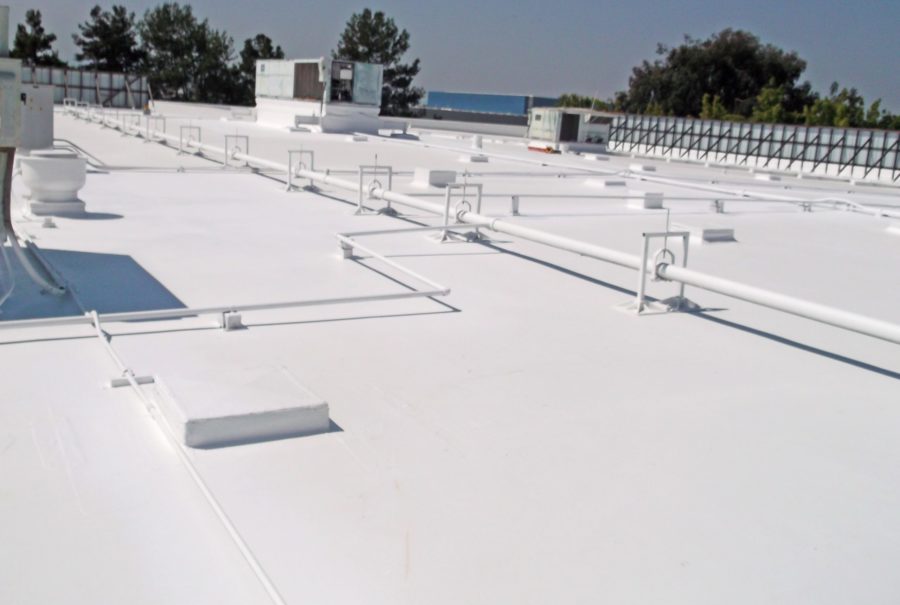TPO stands for Thermoplastic Olefin and is used mainly on Residential and Commercial buildings. It’s a single layer membrane that is low cost and provides protection from ultraviolet light, chemical and ozone damage. Due to its thin membrane (ranging anywhere from 45-89 mm thick, it’s light-weight, long-lasting and stays flexible in order to handle expanding and contracting in a wide range of weather climates. In addition, using TPO can be quite effective in reducing the cost of maintenance.
TPO went through a number of challenges early on in its inception, but it has a reputation as a stellar material that is widely considered a high-quality solution when installing a roof. However roofs installed with this material does have some advantages and disadvantages.
Advantages:
• The lifespan of a TPO roof is roughly 22 to 30 years which is far more than the standard 15 year lifespan with similar polymers.
• One of the benefits when using TPO in your roof is cost. TPO is not very expensive, and costs much less than EPDM (a synthetic rubber) or other rubber roofing counterparts. An additional is the color. TPO tends to be white on top, reflecting sun’s light, and prohibits heat build-up inside.
• You can install TPO a variety of ways, making it much easier than other conventional roofing. It can be attached with an adhesive or directly to the decking. It can be welded around chimneys and resist breaking down when coming into contact with other materials which further demonstrates its flexibility.
• TPO does not require pressure washing and is not likely to have algae or mildew growth. It’s also durable and can resist punctures and tears as well as dirt accumulation. This will also save you money in the long run as you will not need to clean it as often.
• Although TPO is energy efficient, it’s also safe for the environment by helping to lower carbon emissions. This means that in the Summer you can have energy efficiency with a lower energy bill, and enjoy comfy temperatures inside.
Disadvantages:
• Not all TPO is created equal. So while a good deal of TPO is white and inexpensive, there are different types of TPO used by a variety manufacturers. This mean that you could get a good roof with a thicker TPO which customer believe would be better and last longer. However, this is not the case since the thickness of TPO won’t necessarily mean that it’s more durable. All TPO tends to wear out at the same rate regardless of how thick it is. As compounds have changed over the years, it is hard to tell how long current installations will last.
• Lamination that’s used for the roofing’s top layer may cause weak points which may lead to material shrinkage, cracks, and deterioration over the years. Sadly, it is common for some cheaper TPO roofs to develop these cracks in pretty quickly.
• TPO comes in rolls that aren’t very wide. Because of this, contractors have to lay more strips down to cover the area, usually 6 to 8 feet apart. The problem with this is that weather can cause the seams to expand and contract. As a result, the seams can weaken allowing for water to get in.
• Although TPO itself is relatively inexpensive, the cost for installing it on a flat roof can be pretty high. At first glance, this wouldn’t make sense except that since installing a flat roof is easier than a pitched roof; but come to find out, working on a flat roof is actually harder on the back and can slow a contractor down. In addition, a flat roof require adhesives, and in some case a torch is necessary to heat the sealant.
• The home is more susceptible to a leak from a flat roof with water pooling. This happens when the gutters and downspouts get clogged and the water is allowed to makes its way from the home.
• One of its many benefits is that it can reflect heat, however, it isn’t heat resistant. In some Southern states like Florida, Mississippi, Alabama, Texas, Arizona, New Mexico and Southern California where in the Summer high degrees of heat can last for weeks on end, it’s possible that the TPO could fail and greatly decrease the lifespan or your roof.
Contractors and homeowners tend to flat roofs for the looks and convenience. Also, if your plan is to add on to your house, that is to add another bedroom or sunroom, a flat roof can add to the beauty of the existing design. A home with different pitches and dimensions is quite unique.
Whatever type of roof you choose to pursue, be sure to have a conversation with an experience contractor as well as an insurance agent. Your insurance agent can guide you on the style of roof based on claims that have been filed in certain parts of the country. These would be style you may want to avoid.
Having a conversation with an experienced contractor can give you the assurance you need to choose which style is the most effective and least expensive. They can also provide some insight into the aesthetics of your home and how it will look when using certain roofing materials. Taking the time to hammer out all the small details (no pun intended) early on will save you quite a bit of time and money later on down the road.


